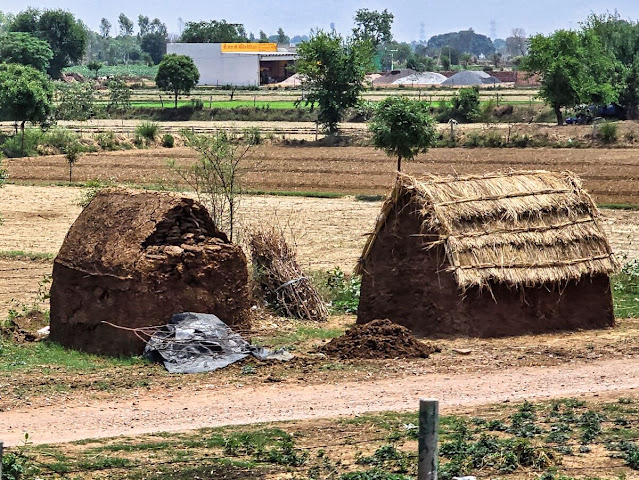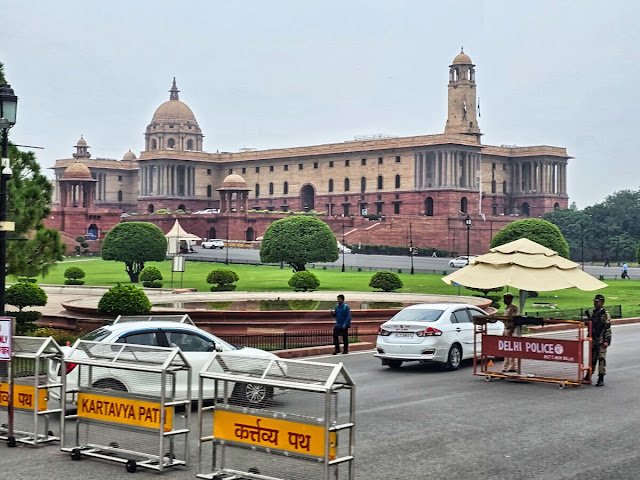Regent Seven Seas Voyager Bangkok to Dubai Day 18 - Agra, India and Agra Fort
We enjoyed a nice breakfast at the hotel before boarding the bus at 9:00 and starting the journey to Agra.
 |
| The hotel was beautiful |
 |
| This massive carnation ball was in the lobby |
We made a detour for a tour around New Delhi.
 |
| Traffic is crazy |
 |
| Cows roam freely - many are owned - banks will give loans against a cow |
We made a couple of passes by the old parliament.
 |
| Sorry this is blurry, but it was carved from a single piece of marble, and it was cool |
 |
| India Gate |
 |
| It is a war memorial |
 |
| Looking for an office chair? |
 |
| Ambedkar Park |
 |
| Sandstone elephants |
After seeing the local sights, we turned South for Agra.
Our guide, Sunny, told us that Hinduism has 33,000,000 gods based on the 33 major gods, plus all families have their own god.. The three main gods are Brahma, Vishnu, and Shiva. Brahma is the creator, Vishnu is the preserver, and Shiva is the destroyer. Together, they are referred to as the Trimurti.
He also explained the history of the Taj Mahal. Per its entry as a UNESCO World Heritage Site, it was built by Mughal Emperor Shah Jahan in memory of his wife Mumtaz Mahal with construction starting in 1632 AD and completed in 1648 AD, with the mosque, the guest house and the main gateway on the south, the outer courtyard and its cloisters were added subsequently and completed in 1653 AD.
So the Taj Mahal was built out of a man's love for his favorite wife. At least he had a harem of concubines to help him through his grief.
We made a comfort stop at a roadside cafe.
After grabbing a couple of Diet Cokes (no Coke Zero at this shop), we got back on the bus for the final two-hour push to Agra.
 |
| We passed several of these - they are temples to the Hindu god Shiva |
More interesting Taj tidbits. It has been widely reported that in order to preserve its unique features, the Shah cut the hands off of all 20,000 artisans and craftsmen who worked on the Taj Mahal. Sunny said that was true, metaphorically. He built them a town immediately adjacent to the Taj Mahal and provided them with more than enough money for the rest of their lives so that they no longer had to work. There was no actual maiming performed. The interesting thing is that all the ongoing maintenance and renovations to the Taj Mahal are done by residents of that town, descendants of the original workers.
As we were driving, we passed many brick factories. The bricks are all handmade. They are fired using cow patties as fuel. Indians, especially rural dwellers, don't have access to natural gas or propane, so cow patties are also a cooling fuel source.
 |
| Huts made from cow patties |
We arrived in Agra, a city of around two million.
After a short drive, we pulled into The Oberoi Amarvilas Agra. To say that the hotel was stunning would be an understatement. We thought the Oberoi in Delhi was beautiful. This one is even better.

 |
| We were presented with fresh carnation leis |
 |
| We got our first view of the Taj Mahal from the lobby |
We went up to our room to drop our bags. We looked out the window and saw this.
 |
| A stunning view from our room |
 |
| The view and the hotel grounds were beautiful |
 |
This note was waiting on our TV
|
We enjoyed a nice buffet lunch before having about an hour to get settled. We met at 4:00 in the lobby to go to the Agra Fort.
 |
| Kingfisher - The King of Good Times |
Akbar built the Agra Fort, also known as the Red Fort. It was started around 1565 and later embellished by his grandson Shah Jahan, who put white marble veneer over some of the red sandstone.
 |
| Sights on the drive |
 |
| Arriving at the fort |
 |
| It is an impressive structure, especially when you consider that it is a century older than the Taj Mahal |
 |
| The color is natural in the stone |
 |
| It's pretty impressive for something 650 years old |
 |
| Tiny chipmunks were running all over the walls |
 |
| What little inlay work remained was beautiful |
 |
| Green parrots were flitting about |
 |
| That's a solid granite bathtub - it was jewel-encrusted until the jewels were looted |
 |
| The stars are Hindu symbols, not the Star of David |
 |
| What makes this place unique is that it was built by a Muslim, but behind us was a Hindu temple - the only one in the world inside a Muslim building |
 |
| Akbar, a Muslim, married a Hindu woman who wouldn't agree unless Akbar built her a temple where she could worship - so he did |
 |
| The Taj Mahal is quite close |
 |
| We're going there tomorrow |
 |
| Akbar's grandson was enamoured with white marble and applied marble veneer to a large part of the fort |
 |
| This was a fountain/bathing pool that was filled with rose water |
 |
| All the lines are glue lines, where the jewels that lined this room were looted |
 |
| A portion of the room was restored to show what it looked like |
 |
| Akbar's son killed his brothers and arrested Akbar so he could become Shah |
 |
| This is the room where Akbar lived his final eight years |
 |
| Amazing inlay work |
 |
| More inlay |
 |
| This family stopped us and wanted to get a photo with us - many folks here don't see westerners often |
 |
| On the way back to the hotel |
After a hot couple of hours at Agra Fort, we returned to the hotel. A shower felt great. We went downstairs where they put on a cultural dance show before serving another nice buffet meal. We enjoyed talking with fellow guests over a good meal.
We returned to the room for an early bedtime. We have to be dressed and ready to go at 4:45 tomorrow morning for sunrise at the Taj Mahal.















































































































Thank you for acting as our tour guide. Appreciate the history lesson, the interesting tidbits, facts, etc., and your beautiful pictures. Looking forward to read your blog for tomorrow. Jean
ReplyDelete